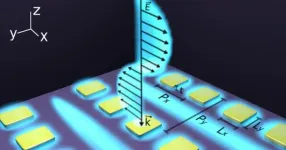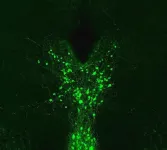Identifying rare genetic variants that increase risk for lung cancer
2021-03-18
(Press-News.org) Lung cancer is the leading cause of cancer death in the U.S. for both men and women. While risk for this disease can be influenced by environmental and lifestyle factors like smoking, studies estimate that 18% of lung cancer cases are due to inherited genetic variants. New research led by Baylor College of Medicine investigates how genetic variants contribute to increased risk of lung cancer.
The researchers performed whole exome sequencing on germline (inherited) DNA from eight large-scale datasets, including 1,045 patients with a family history of lung cancer or early-onset cancer. Those groups are more likely to harbor genetic risk variants. The analysis also included 885 control cases.
"We were looking for variants that have a relatively high impact on risk but occur at relatively low frequency," said Dr. Chris Amos, corresponding author of the study, professor of medicine - epidemiology and population sciences and director of the Institute for Clinical and Translational Research (ICTR) at Baylor. "If a variant occurs at low frequency, you have to look at many different large data sources to validate the variant. These results can be replicated in many different European populations."
The researchers identified 25 new rare pathogenic variants associated with lung cancer susceptibility and validated five of those variants. Of those five, two variants involved genes with known connections to lung cancer risk, ATM and MPZL2. Three variants involved novel lung cancer susceptibility genes, POMC, STAU2 and MLNR. According to co-first author of the study, Dr. Yanhong Liu, exome sequencing allowed the researchers to identify more variants that impact proteins and cell function.
Investigating the contribution of insertions or deletions
"Mutations of DNA where sections are either inserted or deleted have been understudied compared to single nucleotide variants, but they are also very important because they can result in truncated proteins," said Liu, assistant professor of medicine - epidemiology and population sciences and member of the Dan L Duncan Comprehensive Cancer Center at Baylor. "Of the 25 candidate variants we identified, two-thirds of them are insertions or deletions."
In order to further understand the effect of these candidate variants on cellular functions, the Baylor researchers applied endogenous DNA damage assays, which test for replications of certain types of mutations in DNA. They hypothesized that lung cancer risk genes lead to an increased level of endogenous DNA damage in cells, leading to genomic instability and ultimately causing cancer.
"Many studies have looked at lung cancer risk genes, but the function of those genes has not been well understood. In our study, we found that dysregulation or mutations in these candidate genes showed increased DNA damage, suggesting that their potential cancer-causing role might be due to genome instability at the DNA level," said Dr. Jun Xia, co-first author of the study and postdoctoral associate in the Department of Molecular and Human Genetics and ICTR at Baylor.
The analysis showed that POMC, MLNR and ATM variants led to increased levels of DNA damage. ATM is known to be a critical first responder to DNA damage, and several ATM variants are linked to increased susceptibility for multiple cancers. According to Amos, understanding which variants cause increased DNA damage could be key to unlocking treatments for these cancers.
"We know from breast cancer that PARP inhibitors, drugs that prevent DNA repair, work in people with inherited BRCA1 and BRCA2 mutations because those cells already have some DNA damage due to the inherited mutation. If you disable PARP, the cancer cells can't repair DNA damage and won't survive," said Amos, member of the Dan L Duncan Comprehensive Cancer Center at Baylor and CPRIT Scholar. "It's possible that people with inherited ATM mutations causing them to develop lung cancer may respond to those PARP inhibitors as well, and that is something that needs to be studied further."
INFORMATION:
The results are published in the journal, NPJ Precision Oncology.
Other authors from Baylor include Spiridon Tsavachidis, Xiangjun Xiao, Margaret R. Spitz, Chao Cheng, Jinyoung Byun, Wei Hong, Yafang Li, Dakai Zhu, Zhuoyi Song, Susan M. Rosenberg, Michael E. Scheurer and Farrah Kheradmand.
This work was supported by grants from the National Institutes of Health, Intramural Research Program of the National Human Genome Research Institute, and Herrick Foundation. For a full list of authors, affiliations and funding, see the publication.
ELSE PRESS RELEASES FROM THIS DATE:
2021-03-18
Researchers at the University of Ottawa have debunked the decade-old myth of metals being useless in photonics - the science and technology of light - with their findings, recently published in Nature Communications, expected to lead to many applications in the field of nanophotonics.
"We broke the record for the resonance quality factor (Q-factor) of a periodic array of metal nanoparticles by one order of magnitude compared to previous reports," said senior author Dr. Ksenia Dolgaleva, Canada Research Chair in Integrated Photonics (Tier 2) and ...
2021-03-18
Medical cannabis is a subject of much debate. There is still a lot we do not know about cannabis, but researchers from the Department of Neuroscience at the Faculty of Health and Medical Sciences have made a new discovery that may prove vital to future research into and treatment with medical cannabis.
Cannabinoids are compounds found in cannabis and in the central nervous system. Using a mouse model, the researchers have demonstrated that a specific synthetic cannabinoid (cannabinoid WIN55,212-2) reduces essential tremor by activating the support cells of the spinal cord and brain, known as astrocytes. Previous research into medical cannabis has focussed on the ...
2021-03-18
LOS ANGELES (March 18, 2021) -- COVID-19 disproportionately affects men compared with women, raising the possibility that a hormone like progesterone may improve clinical outcomes for certain hospitalized men with the disease. New research from Cedars-Sinai published online in the journal Chest supports this hypothesis.
The pilot clinical trial, involving 40 men, is believed to be the first published study to use progesterone to treat male COVID-19 patients whose lung functions have been compromised by the coronavirus. While the findings are promising, larger clinical trials are needed to establish the potential of this experimental therapy, the investigators said.
The study was prompted ...
2021-03-18
In response to the recent freeze-inspired power outages in Texas, some politicians blamed the historic blackouts on wind turbines. The dubious, and largely dismissed, claims nevertheless spotlighted an intriguing fact: Texas, the land made famous by oil derricks and wildcatters, now gets a significant portion of its electricity from clean, renewable sources, most notably wind, but also from water and solar - a troika of sustainability known collectively as WWS.
"Texas gets about 20 percent of its electricity from wind alone," says Mark Z. Jacobson, a professor of civil and environmental engineering at Stanford University and senior fellow at the Stanford Woods Institute ...
2021-03-18
Technological advances have made it possible for researchers to track the movements of large ocean-dwelling animals in three dimensions with remarkable precision in both time and space. Researchers reporting in the journal iScience on March 18 have now used this biologging technology to find that, for reasons the researchers don't yet understand, green sea turtles, sharks, penguins, and marine mammals all do something rather unusual: swimming in circles.
"We've found that a wide variety of marine megafauna showed similar circling behavior, in which animals circled consecutively at a relatively ...
2021-03-18
What The Article Says: An oncologist reflects on how advising patients with cancer about travel during a pandemic requires a nuanced consideration of benefit and risk, especially when considering lost opportunities when prognosis is limited.
Authors: Christopher E. Jensen, M.D., of the University of North Carolina School of Medicine in Chapel Hill, is the corresponding author.
To access the embargoed study: Visit our For The Media website at this link https://media.jamanetwork.com/
(doi:10.1001/jamaoncol.2021.0125)
Editor's Note: The article includes conflicts of interest disclosures. Please see the article for additional information, including other authors, author contributions and affiliations, conflict of interest and financial ...
2021-03-18
What The Study Did: Researchers examined whether state medical and recreational cannabis laws were associated with changes in rates of self-harm and assault injuries.
Authors: Keith Humphreys, Ph.D., of Stanford University in Stanford, California, is the corresponding author.
To access the embargoed study: Visit our For The Media website at this link https://media.jamanetwork.com/
(doi:10.1001/jamanetworkopen.2021.1955)
Editor's Note: Editor's Note: The article includes conflicts of interest disclosures. Please see the article for additional information, including other authors, author contributions and affiliations, conflict of interest and financial disclosures, and funding and support.
INFORMATION:
Media advisory: The full study and ...
2021-03-18
CHAPEL HILL, NC - Males and females, generally speaking, experience and respond to pain differently, but scientists have yet to understand all the brain circuits involved in these differences. Now, new research from the UNC School of Medicine lab of Thomas Kash, PhD, shows how neurons use dopamine to regulate pain differently in male and female mice.
The discovery, published in the journal Neuron, could help the scientific community devise better pain management strategies, particularly for women, who are disproportionally affected by pain throughout their lifespans.
"We focused on this neural pathway because our previous work and that of others ...
2021-03-18
Low plasma levels of protein TGFB1 and polymorphisms in gene TGFB1 act as biomarkers for the prognosis of gastric adenocarcinoma, according to a study led by the University Complutense of Madrid (UCM).
In particular, these variants are 12% more frequent in patients with metastatic tumors, "which indicates their importance in the clinical progression of this disease", stated José Manuel Martín Villa, Professor of Immunology and researcher at the Department of Immunology, Ophthalmology and Otolaryngology of the UCM.
In addition to identifying patients with poorer progression and high mortality, these markers also identify individuals at ...
2021-03-18
SAN ANTONIO -- March 18, 2021 -- Working with a team led by French astronomers, Southwest Research Institute scientists helped identify incredibly powerful winds in Jupiter's middle atmosphere for the first time. The team measured molecules exhumed by the 1994 impact of comet Shoemaker-Levy 9 to trace winds in excess of 900 miles per hour near Jupiter's poles.
Jupiter's distinctive red and white bands of swirling clouds allow scientists to track winds in the planet's lower atmosphere, and the SwRI team members have particular expertise in the vivid Jovian aurora, associated with strong winds in the gas giant's upper atmosphere. Until now, wind patterns in the cloudless stratosphere, between the two atmospheric layers, have eluded observation.
"The team of ...
LAST 30 PRESS RELEASES:
[Press-News.org] Identifying rare genetic variants that increase risk for lung cancer



